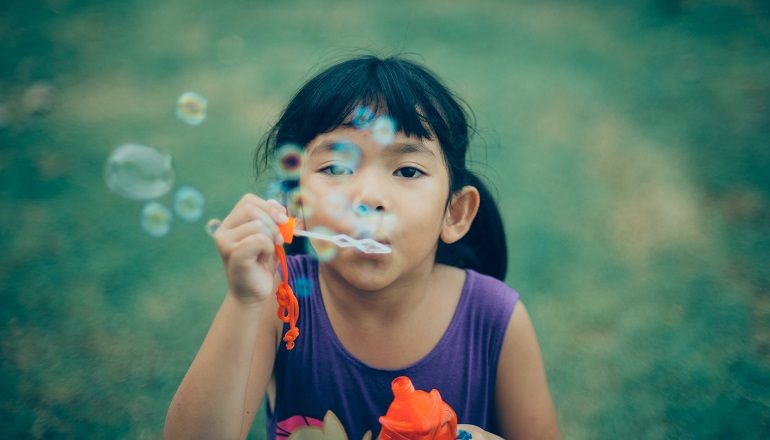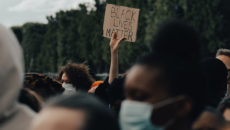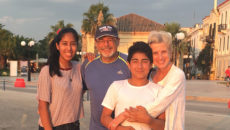Jennifer Klotz, a mom of two transracially adopted children, got a wake-up call when her daughter was in kindergarten: “She came home and told me they had been playing One Potato, Two Potato when one of her friends said, ‘All those with white skin get to go first, and the people with brown skin have to go last.'”
My own wake-up call came one summer afternoon at the kiddie pool when a first-grader whined, “You’re CHI-NEEEEESE!” at my 3-year-old. The child’s parents were nowhere to be found. I was so shocked that I froze, totally unprepared to respond. I had no idea what to say to my daughter except, “Play with someone else.”
In a similar incident, one of Vanessa Gitt’s seventh-grade classmates asked her point-blank, “Why is your face so flat?” Vanessa, who was born in Korea and adopted by her family in Colorado when she was a baby, was devastated. The difference in this episode and my daughter’s: Vanessa and her family had a strategy and a response, while I did not.
“I went home and told my mom,” says Vanessa. “It felt like an insult and it made me feel different and angry.” Vanessa doesn’t remember exactly how she replied. But her parents helped her see that people who tease and make hurtful remarks usually don’t feel good about themselves and are cruel as a result. Not an easy lesson, but one that helped her to be ready in the future.
I later realized that my response on that August afternoon should have been a firm, but calm “Yes, she is Chinese, but why are you saying it that way?” I should have let both the perpetrator and my child know, “No, it’s not OK to say those things. And if you do, I’ll tell you it’s unacceptable.”
Having adopted a child from another culture, I knew I would face racial situations, but I assumed—naively—that it wouldn’t happen when she was in preschool. Wrong.
The Earlier, the Better
Parents in transracial and multicultural families need ways to deal with racism and bias, to instill in our children the confidence to respond on their own, and assure them that insults and slurs needn’t be suffered in silence. Experts suggest talking about cultural differences and bias when children are young. If children are not equipped when the comments come, a difficult situation will be even harder to handle, says Beth Hall, co-founder of Pact, a California adoption-counseling agency.
“We can’t protect our children from racism, so we must prepare them,” says Hall, an adoptive mother and co-author of Inside Transracial Adoption. “That means parents must learn to talk about race, even if it’s difficult at first. Then, when our kids are old enough to process the information, families can talk about race and bias more openly, and kids will learn that the talk is OK.”
Children often don’t tell parents when they’ve been the victim of racial or cultural prejudice, adds Melanie Killen, Ph.D., a professor of human development at the University of Maryland at College Park. So parents must find windows of opportunity for discussion. For example, if your child complains that a friend was being treated unfairly, ask, “Has anyone ever treated you unfairly?” Then discuss how he feels about such incidents and ways to address injustice.
Families must learn to counter insensitive remarks before they happen. We want others to understand that their remarks are wrong or hurtful, and it’s also essential for our children to see us standing up for them. To these ends, families will want to seek out courses and workshops offered in their communities.
School-Age Experience
Children start noticing skin color differences around preschool age, says Dr. Killen, but when they do, they see it as a matter of fact—no bias is present.
In grade school kids may discriminate or exclude based on perceived differences. How we deal with bias depends on several factors. It’s nearly always right to respond to negative racial remarks, devising appropriate responses by considering each situation:
- How old are the children involved?
- Was it a first-time incident or a repeat occurrence?
- Where did it happen—at school in front of teachers or in the neighborhood?
- How did it make our child feel?
When Jennifer Klotz, the mom of the child whose friends told her that people with brown skin go last, reported the incident at school, the reaction was dismaying. The teacher said she thought the episode was innocent. Ultimately, the Klotzes went to the school’s guidance counselor, and the school initiated a diversity-awareness program. Klotz says taking action validated her daughter’s feeling that the incident was wrong.
Another way to battle racism at school: Celebrate diversity. Talk to your child’s class about foods, games, and traditions of her birth culture. Discuss people and customs of other cultures: how we all have different skin, eyes, and hair, yet share many interests.
Your Big, Wide World
Jolynn Oblak, age 30, was adopted by her family in the 1970s. A biracial African American, she credits her European-American parents for their savvy attitudes about race. Before they bought their house, they met the neighbors to determine how diverse the area was, they gave Jolynn dolls that looked like her, and more.
Yet even with her parents’ efforts, Oblak says she struggled with looking different from them and being called an “Oreo” or worse by kids. She believes that transracial families should immerse their kids in a diverse community. “If possible, find babysitters, neighbors, school friends, and merchants who look like your children to help them feel less like outsiders.”
Families must work to help their children understand different cultures and races. Making our homes a safe place to discuss a world that judges people by their color and ethnicity can empower our kids-and be a jumping-off point for tolerance.



